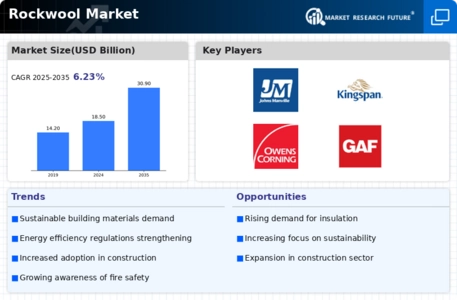Market Share
Rockwool Market Share Analysis
In the competitive landscape of the Rockwool market, companies deploy various strategies to establish and solidify their market share positioning. A fundamental strategy is differentiation, wherein companies strive to distinguish their rockwool products from competitors by offering unique formulations, insulation properties, or specialized applications. This might involve innovations in rockwool manufacturing processes for enhanced thermal efficiency, fire resistance, or sound absorption capabilities. Through differentiation, companies attract customers seeking specific attributes, allowing them to secure a distinctive market share within the Rockwool industry.
Cost leadership is another prevalent strategy in this market, where companies aim to become the low-cost providers of Rockwool. This involves optimizing production processes, sourcing raw materials efficiently, and managing the supply chain to offer competitive prices. Cost leadership is effective in appealing to cost-conscious builders, contractors, and industries where insulation is a crucial component. However, maintaining high-quality standards and ensuring the rockwool meets industry specifications are crucial to ensure customer satisfaction and loyalty in this cost-driven strategy.
Market segmentation is widely adopted in the Rockwool industry. Companies analyze the diverse needs of their customer base and create specialized rockwool products tailored for specific market segments. For instance, they might develop insulation solutions suitable for residential construction, industrial applications, or acoustic insulation in commercial buildings. By addressing the unique requirements of each segment, companies can establish a robust presence within different markets, contributing to an overall enhanced market share.
Strategic partnerships and collaborations play a vital role in the Rockwool market. Companies often form alliances with construction firms, architects, or distributors to strengthen their distribution networks, enhance brand visibility, and expand market reach. Collaborative efforts can lead to shared resources, access to new technologies, and entry into new geographic markets. Through strategic partnerships, companies can navigate industry challenges more effectively, ultimately contributing to a more secure market share position.
Innovation stands as a cornerstone strategy in the Rockwool market, driven by the continual pursuit of improved insulation performance, environmental sustainability, and ease of installation. Companies invest in research and development to introduce rockwool formulations that offer superior thermal resistance, are made from recycled materials, and are designed for efficient installation. Innovations in product design, such as modular insulation panels or solutions for energy-efficient buildings, also cater to evolving construction industry trends. By staying at the forefront of innovation, companies not only attract environmentally conscious buyers but also position themselves as leaders in the Rockwool market, securing a significant market share.
Customer-centric strategies are gaining prominence as companies recognize the importance of providing exceptional customer experiences. This involves offering technical support, educational materials on proper installation, and responsive customer service. Exceptional customer service contributes to satisfaction and loyalty, encouraging contractors, builders, and architects to choose a particular brand for their rockwool insulation needs. By focusing on building strong relationships with customers, companies can solidify their market share and maintain a competitive edge in the Rockwool market.















Leave a Comment